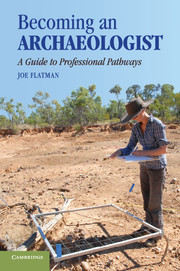Book contents
- Frontmatter
- Contents
- Tables and Figures
- Preface and Acknowledgments
- Introduction
- One What Is – and Isn't – Archaeology?
- Two Skills and Training
- Three Cultural Resource Management
- Four Academia
- Five Local Government
- Six Central Government
- Seven Public and Community Archaeology
- Conclusion
- Appendix 1 Useful Websites
- Appendix 2 Glossaries
- Appendix 3 Suggested Equipment to Take on an Archaeological Project
- References
- Index
Seven - Public and Community Archaeology
Published online by Cambridge University Press: 05 June 2012
- Frontmatter
- Contents
- Tables and Figures
- Preface and Acknowledgments
- Introduction
- One What Is – and Isn't – Archaeology?
- Two Skills and Training
- Three Cultural Resource Management
- Four Academia
- Five Local Government
- Six Central Government
- Seven Public and Community Archaeology
- Conclusion
- Appendix 1 Useful Websites
- Appendix 2 Glossaries
- Appendix 3 Suggested Equipment to Take on an Archaeological Project
- References
- Index
Summary
Introduction
For a long time, archaeologists were generally mysterious individuals largely unknown to the general population. Even if on rare occasion someone knew an archaeologist, he or she probably would not know much about that archaeologist's daily life and would be even less likely to read about the archaeologist's work in the media or visit his or her place of work. After a tentative beginning in the 1950s, though, and an exponential expansion from the 1970s, public archaeology has now become a major component of any archaeologist's life. There are entire careers to be forged in the business of this final chapter – the business of telling nonprofessionals about archaeology, getting them involved, and working for and alongside them.
The most distinctive aspect of this sector is undoubtedly the TV archaeologists whose work regularly attracts millions of viewers per episode. Some TV archaeologists are genuine household names, and they are a recognized cause of a rise in university applications for archaeology courses. Such shows, airing around the world (particularly on the hugely popular Discovery Channel), have had a significant impact on popular culture – so much so that one of the most common questions that an archaeologist is likely to get asked these days on meeting someone new is, “Would I have seen you on TV?”, a strong indication of how deeply enmeshed into popular culture archaeology has become.
- Type
- Chapter
- Information
- Becoming an ArchaeologistA Guide to Professional Pathways, pp. 177 - 196Publisher: Cambridge University PressPrint publication year: 2011

